
Svbony 102ED Doublet
ASI533MC – dedicated cooled camera
SkyWatcher HEQ5 mount
Optolong LeNhance 2″ filter
SVBony 50mm guide scope with ASI120MM guide camera
Miami Valley Astronomical Society
The Universe Is Yours to Discover

Svbony 102ED Doublet
ASI533MC – dedicated cooled camera
SkyWatcher HEQ5 mount
Optolong LeNhance 2″ filter
SVBony 50mm guide scope with ASI120MM guide camera
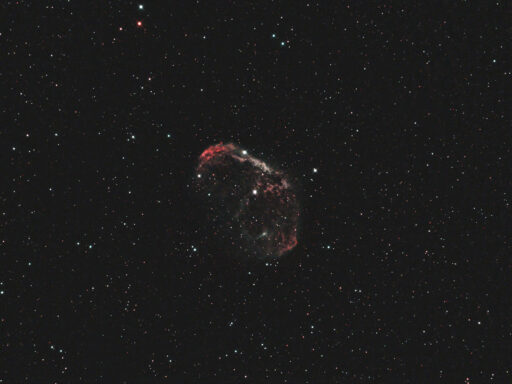
Telescope: Astro-Tech 8” f/8 Ritchey-Chretien, Orion Atlas EQ-G
Camera: Canon EOS Ra, Baader Mk III MPCC, Radian Triad Ultra NB Filter
Guide scope: Astro-Tech 60mm, ZWO ASI120MM mini, PHD2
Exposure: 25x240sec, ISO 3200, saved as RAW
Darks: Internal
Flats: 64×1/5sec, sky flats taken at dusk
Average Light Pollution: Red zone, Bortle 8, good transparency, moonlight
Lensed Sky Quality Meter: 17.2 mag/arc-sec^2
Stacking: Mean with a 1-sigma clip.
White Balance: Nebulosity Automatic
Software: Backyard EOS, Deep Sky Stacker, Nebulosity, Photoshop
The Crescent Nebula is an emission nebula, usually a cloud of diffuse interstellar hydrogen set aglow by hot young stars born within it. However, in this case the nebula was made by a single, massive, fiercely energetic Wolf-Rayet star at its core. Some 250,000-400,000 years ago this star ejected its outer surface while it was a red giant, forming the expanding shell of the nebula. As the star collapsed it ejected a fast moving solar wind that is pushing against the slower moving gas in the shell forming a shock front giving the nebula its distinctive shape.

I am working through some deep sky targets in Cassiopeia. I am still new to processing the narrowband data in SHO. This is one of my first photos that I am really proud of. I will try to share more on here, and on Astrobin as I progress.
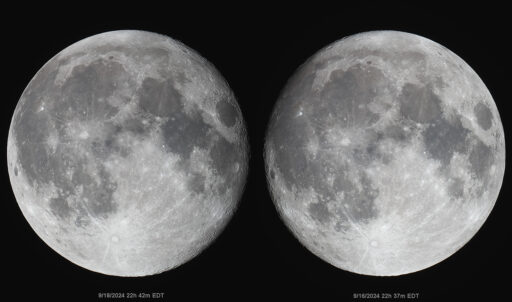
Bookends! The Waxing & Waning Gibbous Moon Before/After the Harvest Moon.
It was cloudy the evening of the Harvest Moon & barely there partial lunar eclipse, but it was clear the night before and after. I ended up with images taken almost exactly 24 hours before and 24 hours after the full Harvest Moon.
Waxing/Waning Gibbous Moon – 9/16/2024 22h 37m & 9/18/2024 22h 42m EDT
Telescope: GSO CC45 (4.5” Classical Cassegrain) @ f/12, Orion Atlas EQ-G
Camera: Canon EOS Ra, Baader Mk III MPCC, GSO IR Filter
Exposure: 75% of 128×1/1000 sec, ISO 1600, saved as RAW
Seeing: Fair, 3/5
Software: Backyard EOS, Nebulosity, Autostakkert, Registax, Photoshop
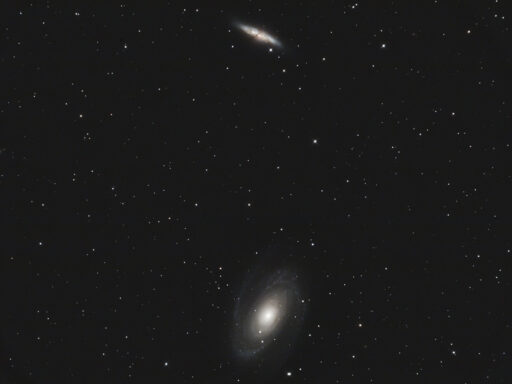
Telescope: Astro-Tech 8” f/8 Ritchey-Chretien, Orion Atlas EQ-G
Camera: Canon EOS Ra, Baader Mk III MPCC, GSO IR Blocking Filter
Guide scope: Astro-Tech 60mm, ZWO ASI120MM mini, PHD2
Exposure: 69x90sec, ISO 800, saved as RAW
Darks: Internal (Long Exposure Noise Reduction On)
Flats: 32×1/250sec, ISO 800, sky flats
Average Light Pollution: Red zone, Bortle 8, fair transparency
Lensed Sky Quality Meter: 18.4 mag/arc-sec^2
Stacking: Mean with a 1-sigma clip.
White Balance: Nebulosity Automatic
Software: Backyard EOS, Deep Sky Stacker, Nebulosity, Photoshop
This is M81 (bottom) and M82 (top), two bright spiral galaxies lying about 12 million light years away in Ursa Major. At present, these two galaxies are about 150,000 light years apart, though a few hundred million years ago the two passed very close to each other. The dark dust lane slashing across M82 is one result of this close encounter with M81 as are the blue star formation regions in M81. Visually, M81 and 82 are fairly easy to see with a modest telescope even from my light polluted backyard. M81 shows its beautiful soft core similar to M31 while M82 shows its elongated shape interrupted by the dust lanes giving it a very irregular shape.
M81 and M82 are currently located to the lower right of the bowl of the Big Dipper during the early evening.
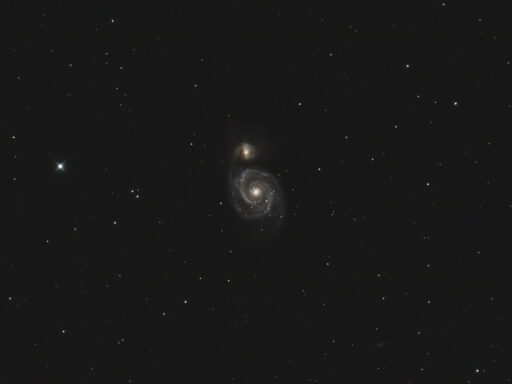
Telescope: Astro-Tech 8” f/8 Ritchey-Chretien, Orion Atlas EQ-G
Camera: Canon EOS Ra, Baader Mk III MPCC, GSO IR Blocking Filter
Guide scope: Astro-Tech 60mm, ZWO ASI120MM mini, PHD2
Exposure: 33x90sec, ISO 800, saved as RAW
Darks: Internal (Long Exposure Noise Reduction On)
Flats: 32×1/250sec, ISO 800, sky flats
Average Light Pollution: Red zone, Bortle 8, poor transparency
Lensed Sky Quality Meter: 18.3 mag/arc-sec^2
Stacking: Mean with a 1-sigma clip.
White Balance: Nebulosity Automatic
Software: Backyard EOS, Deep Sky Stacker, Nebulosity, Photoshop
M51 is a beautiful face-on spiral galaxy in Canes Venatici, just south of Alkaid, the bright star that lies at the end of the Big Dipper’s handle. The spiral arm that appears to connect M51 to the nearby companion (NGC 5195) is a bit of an illusion. The companion actually lies behind M51, and if you look closely you can see that the spiral arm is silhouetted against the background galaxy. Modern observations and computer modeling suggest that the companion has made at least two passes through the main disk of M51. During the first, it approached M51 from behind, passed through the face of the galaxy, swung around in an orbit that took it in front, and then back through the disk where it lies now behind M51. These passes set off bursts of star formation that gives the arms of M51 their beautiful blue color.
M51 is located just off the end of the handle of the Big Dipper high in the northwest as the sky darkens.
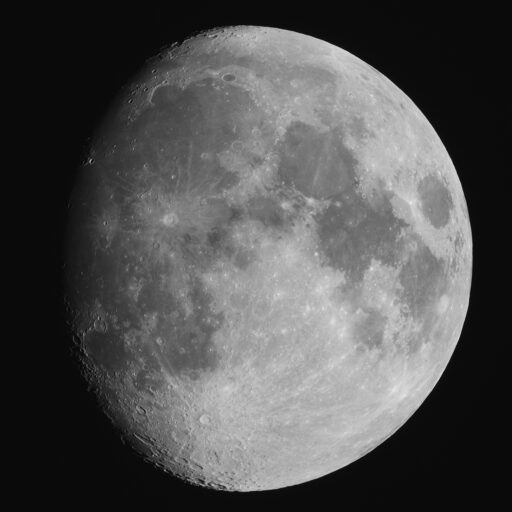
Telescope: Astro-Tech RC8 @ f/8, Orion Atlas EQ-G
Camera: Canon EOS Ra, Baader Mk III MPCC, GSO IR Filter
Exposure: 50×1/640 sec, ISO 800, saved as RAW
Seeing: Fair, 3/5
Software: Backyard EOS, Nebulosity, Autostakkert, Registax, Photoshop
Just a quick peek at the moon between targets on a warm spring evening.

Telescope: Astro-Tech 8” f/8 Ritchey-Chretien, Orion Atlas EQ-G
Camera: Canon EOS Ra, Baader Mk III MPCC, GSO IR Blocking Filter
Guide scope: Astro-Tech 60mm, ZWO ASI120MM mini, PHD2
Exposure: 69x30sec, gain ISO 800 saved as RAW, dithered every 2 images
Darks: Internal
Flats: 32x1sec, Tee shirt flats taken at dusk
Average Light Pollution: Red zone, Bortle 8, fair transparency
Lensed Sky Quality Meter: 18.6
Stacking: Average, 1 sigma clip
White Balance: Nebulosity Automatic
Software: Backyard EOS, Deep Sky Stacker, Nebulosity, Photoshop
M92 is the ‘other’ globular cluster in Hercules. M92 lies to the northeast of the popular M13 globular cluster in a relatively lonely patch of sky making it a bit harder to locate, but well worth the effort. Interestingly, M92 is listed as being fainter than M13 (Mv 6.4 for M92 vs. 5.8 for M13), but I find the core of M92 to be a tad brighter than M13. This is likely the result the apparent size of M13 being larger than M92 giving M13 a higher total integrated brightness.
M92 currently rises in the northeast during the early evening.
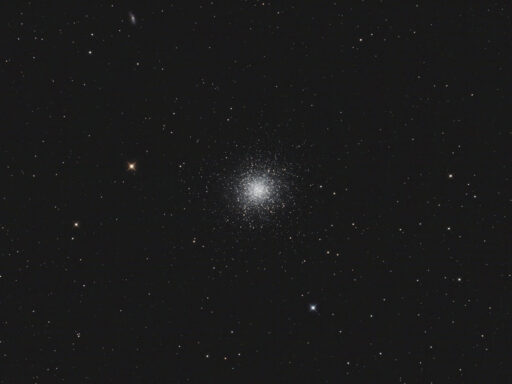
Telescope: Astro-Tech 8” f/8 Ritchey-Chretien, Orion Atlas EQ-G
Camera: Canon EOS Ra, Baader Mk III MPCC, GSO IR Blocking Filter
Guide scope: Astro-Tech 60mm, ZWO ASI120MM mini, PHD2
Exposure: 57x30sec, gain ISO 800 saved as RAW, dithered every 2 images
Darks: Internal
Flats: 32x1sec, Tee shirt flats taken at dusk
Average Light Pollution: Red zone, Bortle 8, fair transparency
Lensed Sky Quality Meter: 18.6
Stacking: Average, 1 sigma clip
White Balance: Nebulosity Automatic
Software: Backyard EOS, Deep Sky Stacker, Nebulosity, Photoshop
This is M13, the Great Cluster in Hercules. Also in the picture is the galaxy NGC 6207 (Mv 11.6) in the upper left along the top edge of this field, and about halfway between NGC 6207 and M13 is the tiny galaxy IC 4617 (Mv 15.2) . If you look carefully at M13 you can see a dust lane to the lower left of the cluster. This is a very unusual feature for globular clusters and it is not clear if this is actually associated with M13 or simply lies in the line of sight with the cluster.
M13 currently rises in the northeast during the early evening.

Telescope: Astro-Tech 8” f/8 Ritchey-Chretien, Orion Atlas EQ-G
Camera: Canon EOS Ra, Baader Mk III MPCC, GSO IR Blocking Filter
Guide scope: Astro-Tech 60mm, ZWO ASI120MM mini, PHD2
Exposure: 36x60sec, gain ISO 1600 saved as RAW, dithered every 2 images
Darks: Internal
Flats: 32x1sec, Tee shirt flats taken at dusk
Average Light Pollution: Red zone, Bortle 8, fair transparency
Lensed Sky Quality Meter: 18.6
Stacking: Average, 1 sigma clip
White Balance: Nebulosity Automatic
Software: Backyard EOS, Deep Sky Stacker, Nebulosity, Photoshop
M95 (right) and 96 (left) are a relatively faint spiral galaxies in Leo. M95 shows a fascinating variety of detail including a compact ring of star formation surrounding the core and a golden bar connecting the core to the nearly circular, tightly wound inner spiral while M96 shows a faint, sweeping outer veil.
Copyright © 2025 · Genesis Framework · WordPress · Log in
Recent Comments